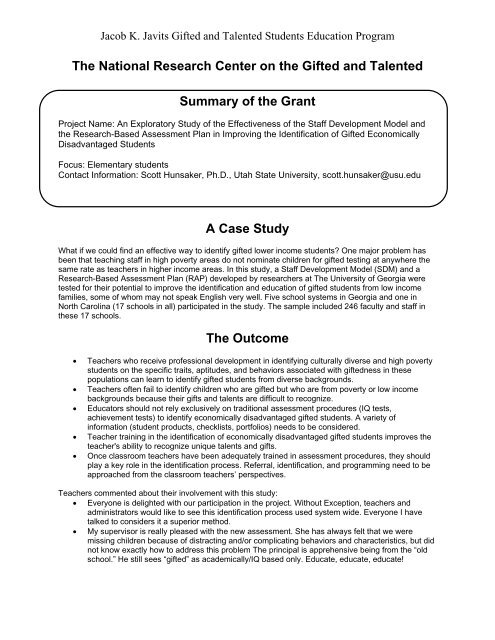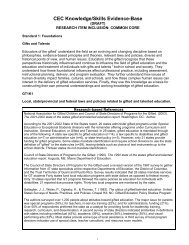Advanced Readers At Risk: Rescuing an Underserved ... - NAGC
Advanced Readers At Risk: Rescuing an Underserved ... - NAGC
Advanced Readers At Risk: Rescuing an Underserved ... - NAGC
Create successful ePaper yourself
Turn your PDF publications into a flip-book with our unique Google optimized e-Paper software.
Jacob K. Javits Gifted <strong>an</strong>d Talented Students Education Program<br />
The National Research Center on the Gifted <strong>an</strong>d Talented<br />
Summary of the Gr<strong>an</strong>t<br />
Project Name: An Exploratory Study of the Effectiveness of the Staff Development Model <strong>an</strong>d<br />
the Research-Based Assessment Pl<strong>an</strong> in Improving the Identification of Gifted Economically<br />
Disadv<strong>an</strong>taged Students<br />
Focus: Elementary students<br />
Contact Information: Scott Hunsaker, Ph.D., Utah State University, scott.hunsaker@usu.edu<br />
A Case Study<br />
What if we could find <strong>an</strong> effective way to identify gifted lower income students? One major problem has<br />
been that teaching staff in high poverty areas do not nominate children for gifted testing at <strong>an</strong>ywhere the<br />
same rate as teachers in higher income areas. In this study, a Staff Development Model (SDM) <strong>an</strong>d a<br />
Research-Based Assessment Pl<strong>an</strong> (RAP) developed by researchers at The University of Georgia were<br />
tested for their potential to improve the identification <strong>an</strong>d education of gifted students from low income<br />
families, some of whom may not speak English very well. Five school systems in Georgia <strong>an</strong>d one in<br />
North Carolina (17 schools in all) participated in the study. The sample included 246 faculty <strong>an</strong>d staff in<br />
these 17 schools.<br />
The Outcome<br />
• Teachers who receive professional development in identifying culturally diverse <strong>an</strong>d high poverty<br />
students on the specific traits, aptitudes, <strong>an</strong>d behaviors associated with giftedness in these<br />
populations c<strong>an</strong> learn to identify gifted students from diverse backgrounds.<br />
• Teachers often fail to identify children who are gifted but who are from poverty or low income<br />
backgrounds because their gifts <strong>an</strong>d talents are difficult to recognize.<br />
• Educators should not rely exclusively on traditional assessment procedures (IQ tests,<br />
achievement tests) to identify economically disadv<strong>an</strong>taged gifted students. A variety of<br />
information (student products, checklists, portfolios) needs to be considered.<br />
• Teacher training in the identification of economically disadv<strong>an</strong>taged gifted students improves the<br />
teacher's ability to recognize unique talents <strong>an</strong>d gifts.<br />
• Once classroom teachers have been adequately trained in assessment procedures, they should<br />
play a key role in the identification process. Referral, identification, <strong>an</strong>d programming need to be<br />
approached from the classroom teachers’ perspectives.<br />
Teachers commented about their involvement with this study:<br />
• Everyone is delighted with our participation in the project. Without Exception, teachers <strong>an</strong>d<br />
administrators would like to see this identification process used system wide. Everyone I have<br />
talked to considers it a superior method.<br />
• My supervisor is really pleased with the new assessment. She has always felt that we were<br />
missing children because of distracting <strong>an</strong>d/or complicating behaviors <strong>an</strong>d characteristics, but did<br />
not know exactly how to address this problem The principal is apprehensive being from the “old<br />
school.” He still sees “gifted” as academically/IQ based only. Educate, educate, educate!

















